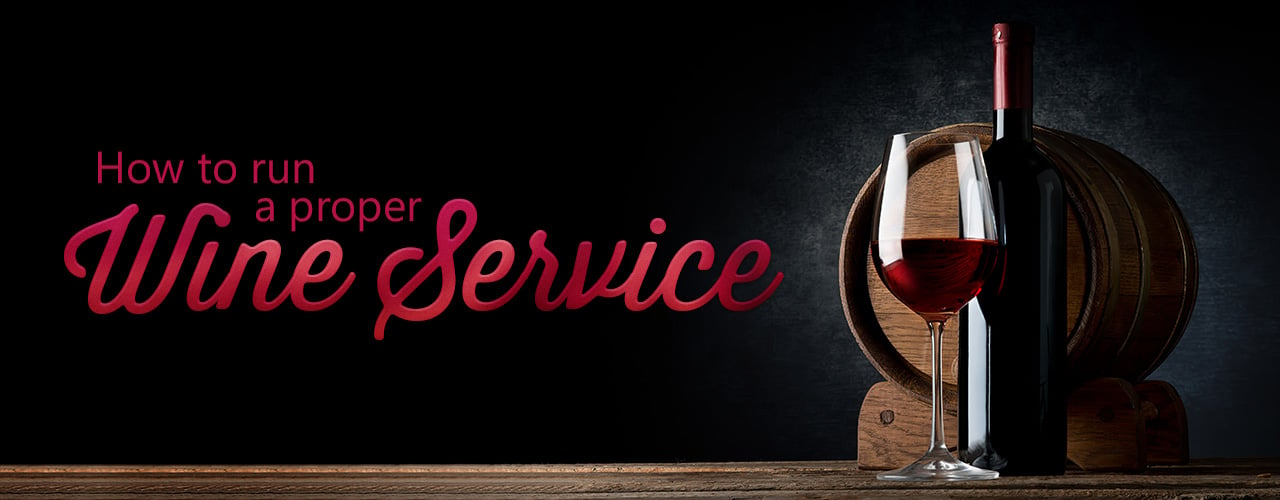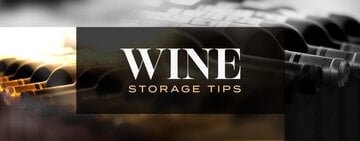
You don't have to own a wine bar to serve great wines. Wine has the unique ability to elevate the guest experience, enhance your menu, and boost your alcohol sales. From swirling wine to holding the glass correctly, wine comes with its own rules of service and etiquette, which can be a little intimidating to the less experienced. We'll walk you through the steps of a proper wine service to help you choose, present, and pour wines for a seamless guest experience.
Shop All Wine SuppliesWhat Is Wine Service?
Wine service is the ritual of serving a whole bottle of wine to a table of guests. If a guest orders a single glass of wine, the full steps of service are not required. Most wines available by the glass are kept behind the bar, and the bartender pours a single glass for the server to deliver. Proper wine service by the bottle is performed at the table by the server.
Watch our video to learn how to perform a professional wine service. For the best wine etiquette, hold the bottle in the air as you open it.
1. Present the Wine List

Not every restaurant needs to serve dozens of wines or hire an in-house sommelier to be successful at selling wine. As long as you create a balanced wine list with a range of price points, you can make it work for you. For instance, if you own a casual eatery with a busy lunchtime crowd, a smaller wine list is appropriate. If you offer full dinner service, your guests may expect a more diverse wine list. Check out our wine list guide to learn more about creating the perfect list of wines.
When all guests are seated, follow these steps to present the wine list:
- Hand each guest a wine list - Present the wine list to each guest from their right side. Never place a wine list on the table. Instead, hand a list to each guest personally when they are comfortably seated.
- Help guests with questions - Be prepared to answer any questions related to food pairings, wine quality, and wine vintages.
- Take the order - After the table has chosen a wine, repeat the order back for confirmation.
- Wines by the glass - Orders for individual glasses of wine are sent to the bar. After the bartender pours the wine, deliver the single glass to the table along with any other beverages. Single glasses don't require the full wine service.
- Wine bottles - Depending on the method of wine storage your restaurant uses, a manager may need to unlock a wine cabinet to retrieve full bottles.
2. Prepare the Wine Glasses

After the table has ordered a wine bottle, you'll need to choose the right glassware. Wine glasses are designed to enhance the style of wine you're serving. To learn more about the different types of wine glasses available, check out our wine glass buying guide. Retrieve the glasses and prepare them for service while the guests look at their dinner menus.
- Select the wine glassware - Choose wine glasses that coordinate with the style of wine, whether it's red, white, or sparkling.
- Inspect the glassware - Make sure each wine glass is free of chips, stains, or blemishes.
- Polish the glassware - Always give the wine glasses a final polish with a clean cloth. Make sure not to leave any fingerprints on the bowl of the glass. Wearing gloves can help with this.
- Place the glassware on a tray - Once the glassware is clean and polished, handle it by the stem and place it on a tray.
- Deliver the wine glasses - Place a wine glass to the right of each guest, being careful to only touch the stem. The position of the wine glass should be identical for each guest. If a guest refuses the glass, discreetly take it away.
3. Wine Serving Temperature

Each style of wine should be served at the appropriate temperature. Wine refrigerators make it easy to control the temperature of your wines down to a specific degree. If you aren't using temperature control, you may need to make some adjustments to bring your wines down to the right serving temp after guests order a bottle. You may also find that guests have preferences when it comes to wine temperature. Be prepared to make adjustments to your wine temps, but follow this general temperature guideline:
- Red wine temperature - Serve red wine just below room temperature at 62 to 68 degrees Fahrenheit. If your red wines are stored without temperature control, consider chilling them slightly before serving to bring the temp down a few degrees.
- White wine temperature - White wines and roses should be served chilled between 50 and 60 degrees Fahrenheit.
- Sparkling wine temperature - Keep sparkling wine stored at 50 to 55 degrees Fahrenheit, but serve it chilled at 40 to 50 degrees Fahrenheit. If guests order a bottle of sparkling wine, chill it immediately to bring the temp down.
4. Opening Wine Bottle

Opening a wine bottle at the table can be intimidating if you aren't familiar with using a wine key. All eyes are on you and if you struggle with the foil or the cork, it takes away from the guest experience. One of the best ways to improve your wine service is to make sure all servers can handle a wine key with confidence.
What Is a Wine Key?
A wine key is a type of corkscrew that is easy to use and fits in a server's apron pocket. Wine keys are also made with a built-in foil cutter. To use a wine key successfully, place the lever against the lip of the bottle to create leverage.
How to Open a Wine Bottle
To open a wine bottle correctly, always handle the bottle in the air and never place it down on a table. Follow these steps to uncork a wine bottle with a wine key:
- Before using the wine key, present the bottle to the guest who ordered the wine. Hold the bottle so the label is clearly visible and announce the vineyard, grape, location, and vintage. Once the guest has confirmed the bottle is correct, you can begin uncorking the wine.
- Cut the foil around half an inch from the lip of the bottle using a foil cutter or the small knife in a waiter's style wine key. This ensures the wine doesn't touch the foil and can help prevent dripping.
- Open the wine key so the corkscrew and lever are both pointed towards the cork.
- Insert the corkscrew, or worm, into the center of the cork and twist.
- Continue twisting the corkscrew down until the first notch on the lever meets the lip of the bottle.
- With the lever pressed against the lip of the bottle, pull the corkscrew up. The leverage created will pull the cork about halfway out of the bottle.
- Now the second notch on the lever will be in line with the lip of the bottle.
- Using the leverage created by the second notch, pull the cork all the way out. If the notch is in place, the cork will pull easily away from the bottle.
- Wipe off the top of the bottle and the cork. This helps remove cork debris and dust from storage.
- Present the cork to the guest in case they want to confirm the branding on the cork matches the bottle.
- Pour a small sample of the wine for the guest and wait for approval before you begin pouring for the table.
5. How to Pour Wine

When the wine bottle is open and the host has approved, it's time to start pouring for the table. Follow these steps to provide a seamless wine pour:
- Before making the first pour, take note of how many guests will be drinking. An average 750 ml bottle of wine will provide approximately five pours. Adjust the pour amount based on the number of guests and never fill a glass more than halfway.
- Wrap the bottle in a clean white napkin or use white waiter's gloves while handling the bottle. This helps with temperature control for chilled wines.
- Traditionally, the oldest woman at the table is served first. The server continues around the table in a clockwise pattern until all women are served, then makes another lap to pour for the men. Today, some find this to be an outdated practice. A more contemporary alternative is to start pouring with the person to the left of the host, regardless of gender, and move clockwise. Either way, the guest who ordered the wine is always served last.
- Always pour from the guest's right side. Finish each pour with a twisting motion and wipe the lip of the bottle to avoid dripping.
- Place the bottle to the right of the host with the label facing outwards and ask permission to remove the cork from the table.
- For chilled wines, ask the guests if they would like a bucket of ice for the table or if they prefer the bottle to be stored in a wine chiller.
- Return to the table periodically to refill wine glasses. When the bottle is empty, ask the table if they would like to order another wine bottle.
Wine Service FAQs
Below we answer some common questions about wine service etiquette:
Should You Smell the Cork?
Guests do not have to smell the cork unless they want to. Smelling the cork can sometimes reveal if the wine has gone bad, but it's not always detectable. The sample pour provides a better gauge of the wine quality. Presenting the cork is a time-honored tradition, but the reason behind it has more to do with confirming the wine brand. If the label on a bottle deteriorates over time, the cork is an additional way to confirm the vintage.
What Do You Do if the Wine is Bad?
If the wine has spoiled, it's customary to provide another bottle. This is why servers need to provide a wine sample and wait for the host's approval. Remove the spoiled bottle and return with a new bottle. Out of sight of your guests, consult with your manager so they can contact the wine distributor about any issues.
Can Customers Take Home an Unfinished Bottle?
Yes, most states allow customers to take home an unfinished bottle of wine as long as it's resealed. Check your state for specific protocols.
How Do You Reseal a Wine Bottle?
Before sending your guests home with their unfinished wine, you have to reseal the bottle properly. Replace the original cork or screw cap and apply a tamper-evident seal to the bottle. Place the bottle inside a clear bag and staple a copy of the purchase receipt to the bag. Now the bottle is safe for travel.
Ensuring your servers know how to pour wine at your bar or restaurant is crucial to creating a warm and welcoming atmosphere for all of your customers, regardless of whether they are enjoying a fine wine. Many guests rely on their waiter or waitress to suggest, present, and serve the perfect wine for their tastes, making it crucial for waiters to know the pertinent facts about each wine and how to serve it accordingly. Wine presentation etiquette is crucial to serving vino, and an outstanding experience can generate return business and improve tips.
Back to Top




